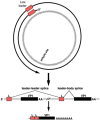Gene Regulation and Quality Control in Murine Polyomavirus Infection
- PMID: 27763514
- PMCID: PMC5086616
- DOI: 10.3390/v8100284
Gene Regulation and Quality Control in Murine Polyomavirus Infection
Abstract
Murine polyomavirus (MPyV) infects mouse cells and is highly oncogenic in immunocompromised hosts and in other rodents. Its genome is a small, circular DNA molecule of just over 5000 base pairs and it encodes only seven polypeptides. While seemingly simply organized, this virus has adopted an unusual genome structure and some unusual uses of cellular quality control pathways that, together, allow an amazingly complex and varied pattern of gene regulation. In this review we discuss how MPyV leverages these various pathways to control its life cycle.
Keywords: RNA decay; RNA editing; nuclear retention; quality control; transcription.
Conflict of interest statement
The author declares no conflict of interest.
Figures






Similar articles
-
Type I Interferons Regulate the Magnitude and Functionality of Mouse Polyomavirus-Specific CD8 T Cells in a Virus Strain-Dependent Manner.J Virol. 2016 Apr 29;90(10):5187-99. doi: 10.1128/JVI.00199-16. Print 2016 May 15. J Virol. 2016. PMID: 26984726 Free PMC article.
-
Global Analysis of Mouse Polyomavirus Infection Reveals Dynamic Regulation of Viral and Host Gene Expression and Promiscuous Viral RNA Editing.PLoS Pathog. 2015 Sep 25;11(9):e1005166. doi: 10.1371/journal.ppat.1005166. eCollection 2015 Sep. PLoS Pathog. 2015. PMID: 26407100 Free PMC article.
-
Murine polyomavirus-VP1 virus-like particles immunize against some polyomavirus-induced tumours.In Vivo. 2005 Mar-Apr;19(2):323-6. In Vivo. 2005. PMID: 15796193
-
How a small DNA virus uses dsRNA but not RNAi to regulate its life cycle.Cold Spring Harb Symp Quant Biol. 2006;71:293-9. doi: 10.1101/sqb.2006.71.017. Cold Spring Harb Symp Quant Biol. 2006. PMID: 17381309 Review.
-
Murine polyomavirus tumour specific transplantation antigens and viral persistence in relation to the immune response, and tumour development.Semin Cancer Biol. 2009 Aug;19(4):236-43. doi: 10.1016/j.semcancer.2009.02.001. Epub 2009 Feb 14. Semin Cancer Biol. 2009. PMID: 19505651 Review.
Cited by
-
Microtubules in Polyomavirus Infection.Viruses. 2020 Jan 18;12(1):121. doi: 10.3390/v12010121. Viruses. 2020. PMID: 31963741 Free PMC article. Review.
-
Replication of JC Virus DNA in the G144 Oligodendrocyte Cell Line Is Dependent Upon Akt.J Virol. 2017 Sep 27;91(20):e00735-17. doi: 10.1128/JVI.00735-17. Print 2017 Oct 15. J Virol. 2017. PMID: 28768870 Free PMC article.
-
Polyomavirus Wakes Up and Chooses Neurovirulence.Viruses. 2023 Oct 18;15(10):2112. doi: 10.3390/v15102112. Viruses. 2023. PMID: 37896889 Free PMC article. Review.
-
Immune sensing of mouse polyomavirus DNA by p204 and cGAS DNA sensors.FEBS J. 2021 Oct;288(20):5964-5985. doi: 10.1111/febs.15962. Epub 2021 May 26. FEBS J. 2021. PMID: 33969628 Free PMC article.
-
Characterization of BK Polyomaviruses from Kidney Transplant Recipients Suggests a Role for APOBEC3 in Driving In-Host Virus Evolution.Cell Host Microbe. 2018 May 9;23(5):628-635.e7. doi: 10.1016/j.chom.2018.04.005. Cell Host Microbe. 2018. PMID: 29746834 Free PMC article.
References
Publication types
MeSH terms
Grants and funding
LinkOut - more resources
Full Text Sources
Other Literature Sources

